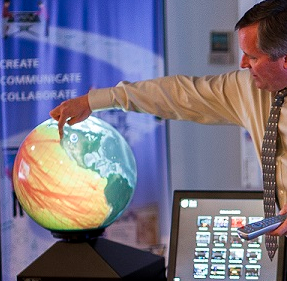Sydney Opera House
10 July 2014
The ITEC 2014 Conference provided a superb opportunity to focus on the benefits of connecting and collaborating globally in education. To follow are some highlights from the day.
Visual Global Collaboration – Via Skype
Greg Zorbas, Kenai Central High School and Rob Sparks, Skyview High School Alaska spoke of their experience with connecting classrooms and virtual visits to places using video conference technology. Both were passionate about the positive effects connection had on student interaction and depth of understanding content through interacting with others. They noted that through the use of video conferencing students have a chance to ask questions that a teacher may not think of.
Asia ConneXions 
Live from Japan and Korea students performed via video conference at the ITEC 2014 conference.
Anyang Shingi Elementary School K orea, Traditional Music ITEC 2014 example 1
orea, Traditional Music ITEC 2014 example 1
Higurashi Elementary School Japan, Traditional Dance ITEC 2014 example 2
“Australian and Asian schools connecting digitally in order to develop cultural and language exchange while fostering understanding between Australian and Asian students and teachers. Through videoconferencing and online discussions, the school children see each other, talk to each other, and learn about each other. These Asia ConneXions interactions enhance the values and attitudes of Australian and Asian school students.”
Source: http://www.une.edu.au/about-une/academic-schools/school-of-education/teaching-and-learning-projects/asia-connexions
Virtual Learning Project – Exploring Pedagogy for Video Conferenced Classrooms
Jo Tate Senior Project Officer Vic. Virtual Learning Project
Dr Myung-Sook Auh Senior Lecturer UNE
Tips for setting up a video conference:
- Keep it simple, but plan ahead
- Have a planning meeting between two groups – good time to test connection and set up time schedule
- Think about lighting, sound, camera
- Set cameras and sound before the video conference, testing cameras and audio is essential
- Consider the backdrop
- Solid colour of clothing of the presenter is important, think about distractions of busy colour and images
- Important to think about the set up and placement of students
- Provide a variety of activities during a video conference – move between slides, cut back to live
- Slides – think carefully about image choice and use of text
- Engagement – talk to the audience
- Relevant speakers that will add to student learning
- Allow time for students to engage, ask questions, involve the students
- Getting to know you stage – for students picture of children and names provided to the other group
- Don’t be afraid of it not being perfect
Ideas for VC with schools:
- Q&A
- Share created objects/work
- Interact with other class – game, data collection
- Use other class info to solve a problem or a mystery
- Create something together
The Amazing eClassrooms
Anne Mirtschin
Ideas for Video Conferencing:
- Bullying: No Way day early in the year great for cyber safety – students using backchat were able to ask questions
- Virtual book character dress up day
- Safer internet user day
- See Share Shape – hands on literacy with pottery. Also drawing activities with Mark Wilson where students engage in the activity
- Feedback from students very useful in planning for additional VC’s
More ideas from The Amazing e-Classroom – Backchannel for questions, resources, comments
Building Global Classrooms with Asia
Jo Tate Senzior Project Officer Vic. Virtual Learning Project
Dr Myung-Sook Auh Senior Lecturer UNE
Australia–Asia BRIDGE School Partnerships Project
“The Australia–Asia BRIDGE School Partnerships Project connects Australian teachers, students and school communities with their counterparts in Asia.
What does BRIDGE do?
- strengthens the Asian language capabilities of Australian students via direct personal experiences that motivate language learning
- builds intercultural understanding among teachers and students in Australia and Asia
- enhances digital capabilities among participating teachers and students
- supports high quality Asian language teaching and programs in Australian schools.”
Other presenters:
FARLABS Freely Accessible Remote Laboratories
Cathal O’Connel, La Trobe University
Linking classroom with science Laboratories: ‘Through the establishment of a virtual laboratory network this project will bring the state-of-the-art facilities and world-class research of Australia’s Universities directly into our schools to engage high-school students with science and maths nationally.’
Access via e-Virtual laboratory targeted years 7-12, fully integrated with Australian curriculum. Key topics Nuclear, Environment, Structure. Teacher notes are available.
Teachers/students log in and control scientific equipment, content free experimental science, ultimately provides a remote laboratory.
Fizzics Education
Ben Newsome
http://www.fizzicseducation.com.au
Science shows for schools can be booked as a visit or via VC.
Magic Planet Global Imagination
3D multimedia visualization, vast library of global content. Scalable platform that grabs the attention and taps the learning strengths of each student in the classroom.
Source: https://interactivewhiteboardnetau.files.wordpress.com/2014/07/magic.jpg
Sydney Opera House Education
‘The List Operators’ new VC program
Themes – relationships, content and structure, styles of engagement, change in understanding
